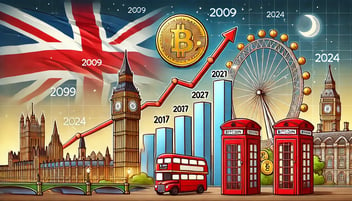Is Bitcoin ‘Digital Gold’?
To understand whether Bitcoin really is digital gold, we compare the two assets on scarcity, portability, divisibility, and volatility.
Bitcoin, the first cryptocurrency and largest by market cap, is fifteen years old. Since its launch in January 2009, it has drawn comparisons to another investment: gold.
Even before this, in late 2008, as the pseudonymous Satoshi Nakamoto published the Bitcoin whitepaper, the writer references gold:
"The steady addition of a constant amount of new coins is analogous to gold miners expending resources to add gold to circulation. In our case, it is CPU time and electricity that is expended." - Bitcoin Whitepaper
Since 2016, Google Trends data shows a steady increase in searches for “digital gold”:
Source: Google Trends
These comparisons continue to be drawn in recent years.
“I could potentially see Bitcoin become the 21st-century gold” - Marion Laboure, Analyst at Deutsche Bank Research.
In 2017, Larry Fink, CEO of $10tn+ asset management firm Blackrock, called Bitcoin an index of money laundering. In July 2024, he said he was wrong and called it digital gold live on CNBC.
But what exactly does the term digital gold mean?
Simply put, digital gold could be an investment asset that offers capabilities beyond the physical version:
- Access to liquidity from global marketplaces
- Can be traded to transfer ownership
- The asset can be cost-effectively purchased
- Transactions completed online
Blockchain technology can facilitate these capabilities, and use cases for gold and Bitcoin include payments, hedges against inflation, and stores of value. As with any digital solution, there can be liquidity delays when selling or trading.
This article will define both assets and uncover whether Bitcoin is worthy of the digital gold moniker.
What is Gold?
Gold is a popular asset for investments thanks to its long history as an international monetary currency - spanning thousands of years - and its recognisable quality. It is prized both for its beauty and for its varied use cases. Gold is used across many applications beyond investment, from jewellery to industrial applications, where its electric and heat conductivity properties make it extremely useful.
These use cases subject gold to supply and demand economics, and its price has risen over time.
What is Bitcoin?
Bitcoin (BTC) is the native cryptocurrency of the Bitcoin blockchain, a decentralized distributed ledger and network. It is the network’s coin, used as a native currency, that pays transaction fees to miners for mining the coins and as an asset.
Further, Bitcoin's intended use—per the Bitcoin whitepaper—is not to be used as a physical resource like gold but to reduce or remove reliance on central bank-issued fiat currency. It does this through its capacity for peer-to-peer exchanges, which require no middleman (in this case, a bank).
In this article, we’ll refer to Bitcoin, the coin, not the Bitcoin blockchain.
Comparison of Bitcoin and Gold
We must evaluate both assets across several factors to understand whether Bitcoin can be called digital gold.
Scarcity and Supply
Bitcoin
Michael Saylor, one of the leading proponents of Bitcoin, claims that it is “digital scarcity.”
Bitcoin is hardcoded to always have 21 million coins in circulation. By August 2024, 19.7 million Bitcoins had been mined, with the total supply expected to be mined by 2140.
Access to some Bitcoins has been lost through the loss of private keys, reducing the overall supply over time. According to research by Chainalysis, a blockchain data platform, 17%–23% of the overall Bitcoin supply, which ranges between 2.78 million and 3.79 million BTC, might be lost.
Gold
Gold is a scarce asset; it is not abundant in supply. Estimates from earlier this year suggest that over 240,000 tonnes of gold have been discovered throughout history.
The current market capitalisation (price x available supply) of gold is over £12.8 trillion and data from the World Gold Council indicates only around 2,500 tonnes are mined each year. Estimates suggest there are over 50,000 tonnes of gold still below ground waiting to be mined. We know that there is gold in space, on asteroids and other celestial bodies – space mining may become a burgeoning industry in future.
The table below gives a quick overview of the nature of gold and bitcoin's scarcity (what makes them scarce), how their supplies grow or shrink, and the total supply volume. Verification is relevant because it proves the assets' existence.
|
Gold |
Bitcoin |
|
|
Nature of Scarcity |
Natural, geological |
Algorithmic, digital |
|
Supply Increase |
Gradual, influenced by mining technology and economic conditions |
Predetermined, halving schedule (every four years, miner rewards halve) |
|
Supply Cap |
No cap |
21 million coins |
|
Verification |
Physical inspection |
Digital verification on blockchain |
Durability and Longevity
It is harder to compare these factors due to Bitcoin’s comparatively short history when compared to gold and also in comparing a physical asset with a digital one, but there are still factors worth examining:
|
Gold |
Bitcoin |
|
|
Physical Durability |
Extremely high |
Not applicable |
|
Digital Durability |
Not applicable
|
Extremely high |
|
Longevity Factors |
Intrinsic properties from industrial and retail use cases |
Technological, adoption, regulation, security |
Divisibility
To function correctly as a currency, an asset must be fungible – or divisible – and able to be split into smaller units. Gold is typically measured in grams and troy ounces, whilst each Bitcoin is comprised of 100 million satoshis. Gold is less divisible than Bitcoin, and breaking it into smaller units can be impractical.
Portability
Gold is a heavy physical asset that is expensive to move, especially across international borders where strict limits are placed. It must be insured and securely stored, often by a third party.
Bitcoin can be sent internationally from one individual to another. There are still risks to transferring Bitcoin—one must ensure Bitcoin addresses are correct—but thanks to its digital nature, it is highly portable.
Storage
As mentioned, gold is often stored in a vault on the owner’s behalf. These vaults charge storage and insurance fees.
Self-custody of Bitcoin is low-cost and often free when stored in a custodial wallet or exchange.
Both assets are vulnerable to security challenges such as theft, and owners must store them responsibly and safely.
Intrinsic Value
Investors perceive Gold to have clear intrinsic value thanks to its use in retail and industrial applications and comparative rarity. The resources expended to mine and prepare gold for usage—which in 2023 reached record highs—could also attribute value to the finished product.
As a digital asset, Bitcoin seemingly has no intrinsic value. However, the same argument that the resources it takes to mine 1 Bitcoin could be attributed as value applies here, much like it does with gold.
One can see from the chart below that the cost of mining a bitcoin is closely associated with its price in US Dollars:

Source: Macromicro
Store of Value
As a newer asset class, Bitcoin’s potential as a store of value is not yet established. However, numerous data points can illustrate Bitcoin's historical role in maintaining potential value over time, as shown in this chart:
Bitcoin is a volatile asset. Volatility is not traditionally associated with stores of value. It is best seen as a speculative, high-risk investment asset.
Gold’s store of value potential is widely accepted and agreed upon.
Market Perception and Acceptance
As highlighted by the Larry Fink quote above, Bitcoin’s market perception has shifted dramatically since its inception. The SEC's recent approval of Bitcoin Spot Exchange Traded Funds (ETFs) has helped bring investing in Bitcoin into the mainstream, making the asset accessible to traditional investors looking to use the familiar mechanism of ETFs. These ETFs have seen billions of dollars of inflows since their launch.
Whilst media attention has greatly lifted the appeal of Bitcoin ETFs, they are not available for sale in the UK because they don't issue a Key Investor Document, according to AJ Bell’s head of investment analysis, Laith Khalaf.
Real-World Entities Holding Bitcoin & Gold as Stores of Value
Governments worldwide and significant national and international companies have invested in and continue to hold Bitcoin. Examples include:
El Salvador – This country made Bitcoin legal tender and holds more than 5,700 bitcoins.
Microstrategy – Michael Saylor’s Microstrategy holds more than 1% of the total Bitcoin supply.
Tesla – Tesla Inc. hold over 10,000 Bitcoin.
Germany recently made headlines by selling off $3bn of Bitcoin.
Data from popular aggregator Coingecko shows that Governments account for over 2% of all held Bitcoin. Here are the biggest holders:
- USA – over 200k Bitcoin
- China – 190k Bitcoin
- United Kingdom – 61k Bitcoin
Similarly, central banks in the global south have also been stockpiling gold, with massive investments from the People’s Bank of China and India’s Reserve Bank.
Former President Trump’s comments at the Bitcoin Nashville Conference in 2024 suggest that he would hold Bitcoin as a strategic reserve asset.
Advantages and Disadvantages of Bitcoin as Digital Gold
There are numerous advantages and disadvantages to Bitcoin operating as digital gold, and we’ve collated the top ones below:
Advantages
- Scarcity
- Divisibility
- Portability
- (Digital) Security
Disadvantages
- Volatility
- Regulatory uncertainty
- Lack of intrinsic value
These advantages and disadvantages may change over time as Bitcoin's community continues to develop it. Volatility and lack of intrinsic value are key risks that investors need to be aware of (and get used to). Volatile assets are often considered riskier than less volatile assets because the price is expected to be less predictable. Regulatory oversight may affect investors in different ways, depending on location, and again, there are facets of crypto assets that investors must understand.
Future Prospects of Bitcoin as Digital Gold
Technological innovations such as Bitcoin’s Lightning Network and Layer-2 scaling solutions primarily reduce the oldest chain’s expensive and lengthy transaction fees and costs.
Institutional and mainstream adoption will be critical drivers of Bitcoin’s future and its status as 'Digital Gold'.
Will Marion Laboure be proven right in her prediction? Only time will tell, but we know one thing for sure: at this point, Bitcoin is the 10th biggest asset in the world by Market cap.
Investing in Gold and Bitcoin carries significant risks and may not be suitable for all investors. Both assets are highly volatile and may experience substantial price fluctuations. Unlike regulated financial products, physical gold and cryptocurrencies like Bitcoin are not protected by the Financial Services Compensation Scheme (FSCS), and investors may lose all or part of their investment. Before investing, ensure you fully understand the risks and seek independent financial advice if necessary.
Disclaimer: Investing in and holding qualifying cryptoassets involves risks that differ from those associated with mainstream investments such as listed or exchange-traded securities. Please ensure you fully understand the risks before proceeding.
Approved by Archax on 26/09/2024


